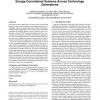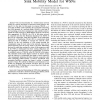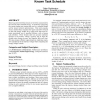200 search results - page 39 / 40 » Worst-case lifetime computation of a wireless sensor network... |
CASES
2006
ACM
13 years 11 months ago
2006
ACM
Rising interest in the applications of wireless sensor networks has spurred research in the development of computing systems for lowthroughput, energy-constrained applications. Un...
EWSN
2006
Springer
14 years 4 months ago
2006
Springer
Energy-aware algorithms have proven to be a crucial part of sensor network applications, especially if they are required to operate for extended periods of time. Among these, effic...
ICCCN
2008
IEEE
13 years 11 months ago
2008
IEEE
—The core functionality of a wireless sensor network (WSN) is to detect deviations in expected normal behavior and report it to the sink. In this paper, we propose TRACK — a no...
ICCAD
2006
IEEE
14 years 2 months ago
2006
IEEE
Battery-powered wireless sensors are severely constrained by the amount of the available energy. A method for computing the energy budget per sensing task can be a valuable design...
ICCCN
2007
IEEE
13 years 11 months ago
2007
IEEE
— Autonomous localization of nodes in wireless sensor networks is essential to minimize the complex self organization task and consequently enhancing the overall network lifetime...



